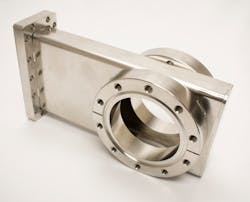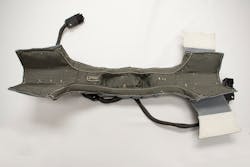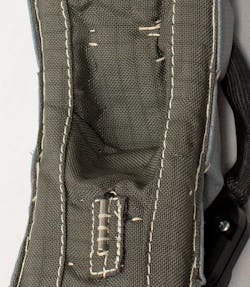Tips for optimizing your heating system for energy efficiency and cost savings
Pipe system heating is necessary to control certain processes, prevent condensation and reduce/control viscosity of liquids as they flow from one point to another. Electric heating is one of the top choices for pipe heating applications, and proper system design is critical. Using a less efficient system is like throwing your energy dollars out the window.
The keys to energy efficient heating systems include:
- Selection of insulating material
- Pipe and component heaters
- Proper installation techniques
This article examines the importance of proper system design and focuses on the special needs of irregularly shaped components such as valves, pumps, flow meters, flanges and strainers.
Insulating material selection
Material selection is a critical component to energy efficiency. Different materials and thicknesses impact system efficiency. Application temperature, installation environment and durability are vital considerations. Fiberglass, silicone sponge and closed-sell elastomeric insulating foam are the most popular options. Fiberglass and silicone sponge can be used in all-in-one heating jackets, or as insulation placed over top of separate heaters. Heating jackets are heaters with built-in insulation that may include fabric covers. Fabric covers are used to prevent UV degradation, unintentional damage or environmental wear of the insulation.
Fiberglass
A fiberglass insulating jacket is made by sandwiching the insulation between two pieces of fabric selected specifically for the application. Outdoor applications require moisture-resistant fabrics to prevent water or other liquids from saturating the insulation and decreasing performance (reduced R-Value). The jacket may also protect the insulation from abrasion or unintentional tearing. Fiberglass has a low thermal conductivity and is suitable for high-temperature applications, as well as lower temperatures.
Silicone sponge
Silicone sponge can be manufactured in different ways that impact the overall performance. However, application temperatures are typically below 450°F (232°C) and it often lacks resistance to wear. A silicone jacket may be placed on the outside of the sponge to increase durability. The cost of silicone sponge is often higher than fiberglass.
Closed-cell elastomeric foam
Elastomeric foam costs less than silicone sponge but has a much lower temperature rating — 220°F (104°C). Tubular foam is flexible, even at colder temperatures, and used in industrial and residential applications. This material is well suited for freeze protection, insulation of hot water pipes and condensation protection.
Insulation thickness
After determining which types of material may be suitable, it is necessary to determine insulation thickness based on the application. The thicker the material layer, the less the heat loss as compared to a thinner layer of the same material. Insulations are available in different densities which will impact the thermal conductivity of the material. Be sure to consider requirements for exterior temperature. If the temperature of the outside surface exceeds 140°F (60°C), it may be necessary to add protective guards to maintain a safe working environment. Weigh the cost of guards against the cost of thicker insulation, but also consider how physical barriers may prevent required access for maintenance. Well-constructed, fiber-filled cloth jackets have life expectancies of more than 10 years.
Energy efficiency
To better understand how insulation can impact energy efficiency in a piping system, two materials are used for comparison. Due to temperature limitations, the closed-cell elastomeric foam is not included in this comparison. The fiberglass insulation has a density of 9.1 lbs/cu. ft. and is rated for up to 1200°F (648°C). The silicone sponge insulation is a closed-cell variety that has a density of 29 lbs/cu. ft. and is rated for up to 500°F (260°C). The thermal conductivity ratings are in Table 1.
Energy usage was calculated based on maintaining an exterior tube temperature of 300°F (149°C) in an area having an ambient temperature of 77°F (25°C) and natural convection of 4.406 BTU/hr/ft2/°F (25 W/m2/°K).
In this example, using a cloth insulating jacket made with half-inch fiberglass mat will be 31% more energy efficient than using an insulator made with the silicone sponge material (Table 2). Consider the same tube without insulation and over 307 watts per foot is required to maintain a temperature of 300°F (149°C).
Convert this to dollars spent to maintain process pipe temperatures. If a company uses 80,000 kW-hr per month, and pays $0.06409 per kilowatt-hour, over a year’s time that amounts to $61,526. If the piping is currently insulated with silicone sponge and switched to fiberglass, the energy bill can be reduced by $19,073 a year. Imagine the savings if there is currently no insulation being used.
Pipe and component heaters
Electrical component heaters may be integrated into the insulator itself or may be separate elements placed between the object to be heated and the insulating material. Cloth heating jackets, flexible heating tapes, heat-trace cable and Mineral Insulated (MI) cable are potential options for component heating. Select heaters with required wattage and a coverage area based on heat losses for the insulation to be used. These can be cost effective “off-the-shelf” solutions for heating simple shapes because these heaters are able to provide the good surface coverage required to heat and maintain temperature. Before deciding on this option, consider installation and maintenance requirements.
Valves, pumps, flow meters, flanges and strainers pose special challenges. Their complex shapes and variable masses make it especially important to properly heat and insulate as much surface area as possible. If a 4-inch gate valve shown in Figure 1 has hot gas flowing through it, the valve will quickly lose heat due to the mass of the valve body which acts like a heat sink. The exposed surfaces of the valve present more area for dissipation of heat and direct contact with a heater is more difficult. Without enough heat, gases could condense, particulates fall out of suspension or more viscous materials clog, which decrease performance of the valve. The most effective and energy-efficient option for heating and insulating these components would be an insulated heating jacket.
Figure 2 shows the valve with a custom cloth heating jacket and integrated controller. The jacket has been removed in Figure 3 to display stitching on the inner fabric of a custom cloth. A temperature sensor is sewn to the outside of the fabric where it will be in direct contact with the valve body. Heat loss calculations are used to determine the maximum wattage requirement to heat or maintain the fluid temperature travelling through the valve. Based on voltage and the total surface area of 61 square inches, the alloy and length of wire is determined. Shielded resistance wire is sewn to the fiberglass insulation which has been cut in a shape to cover the entire surface. The white thread seen on the inner fabric of Figure 4 shows locations were the insulation with wire is secured to the fabric.
Proper installation techniques
Proper installation of heaters and insulators can be key to not only energy efficiency, but also the quality of the material flowing through the system. Whether it is fuel gas, heating oil, steam, honey or any other fluid, your process has requirements for fluids exiting the system. Installation of heaters and insulation is critical to meeting that requirement. When using heating tape or cord, placement around the part — including uniform spacing, tight wrapping to maintain direct contact, no overlapping and securing to the object — are as important as selecting the correct wattage. Insulation should fit securely over the object being heated, not allowing any gaps where heat may be lost. The insulation should not be used as a means of securing the heater in place. Due to the critical methodology of installation, if routine access is required for maintenance, this may not be the best permanent solution, even if simple shapes are being heated. Also note that some tapes have specific temperature ranges that may limit their ability to be reused.
Cloth heating jackets are designed for easy removal and reuse. Unlike using heating tape or cord, the location of the heating wires will be the same every time that jacket is removed and reinstalled. Each heating jacket is designed to match the dimensions of the component and must be tight to ensure the sensor and heating wires are in contact with the component. Suppliers of heating jackets often provide options for various fastening systems with some easier to use than others. Hook-and-loop is the most popular with other options being hook-and-lace, D-Ring and strap, snaps, buckles and grommets.
Conclusion
Energy consumption can be a major expense to all companies, not just manufacturers. However, manufacturers using piping for transmission of gases or liquids can reduce their energy consumption by having thorough system design. Using the tips presented here will help reduce energy usage by increasing system efficiency. That not only saves money but is important to the global environment. Insulation and heater selection, as well as proper installation, are key factors in system design and require careful consideration. Irregularly shaped components such as valves, pumps, flow meters, flanges and strainers require special consideration due to the mass to be heated, as well as large surface areas.
Edye Buchanan is a marketing strategist at BriskHeat Corporation. She’s driven to uncover new technologies and channels in the industrial surface and immersion heat, insulator and temperature control markets including composite manufacturing and repair. Buchanan’s more than 30 years of experience in manufacturing has focused on design engineering, project management, and marketing. Buchanan holds a Bachelor of Science from Kent State University and is a Certified Manufacturing Technologist.






